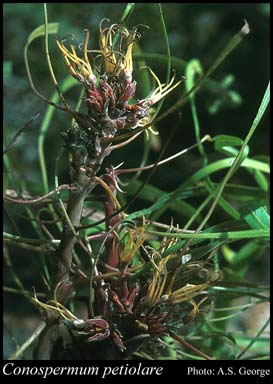- Reference
- Prodr. Suppl. 11 (1830)
- Conservation Code
- Not threatened
- Naturalised Status
- Native to Western Australia
- Name Status
- Current
Densely branched, non-lignotuberous shrub, 0.3-1 m high. Fl. cream-orange-yellow-brown/pink, Oct to Dec or Jan to Mar. White or yellow sand over granite or quartzite, gravel, black peaty sand. Rocky slopes, winter-wet areas.

Scientific Description
Shrubs, 0.5-1 m high; branchlets hairy. Leaves alternate, 100-360 mm long, 3-15 mm wide, glabrous; lamina flat, more or less the same width throughout, entire, erect. Inflorescences leafy, the flowers aggregated into distinct clusters, the clusters sessile, cream, yellow, orange or pink, hairy; floral bracts 6-10 mm long, hairy. Perianth 15-30 mm long, irregular, hairy; upper lip 11-23 mm long, hairy; lower lip 10-22 mm long, hairy. Nut 2-2.5 mm long. Flowers in January, February, March, October, November or December. Occurs in the South-west (SW) Botanical Province(s), in the Jarrah Forest (JF) or Esperance Plains (ESP) IBRA subregion(s).
Distribution
- IBRA Regions
- Esperance Plains, Jarrah Forest, Warren.
- IBRA Subregions
- Fitzgerald, Southern Jarrah Forest, Warren.
- IMCRA Regions
- WA South Coast.
- Local Government Areas (LGAs)
- Albany, Cranbrook, Gnowangerup, Jerramungup, Plantagenet, Ravensthorpe.